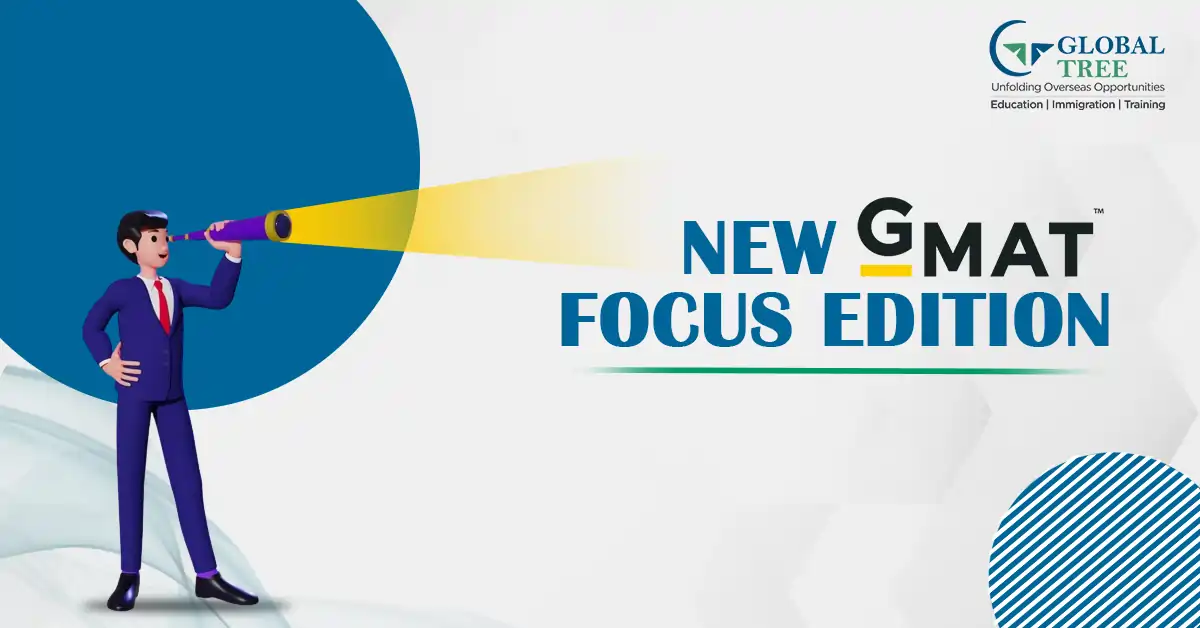GMAT Focus Edition - Data Insights Section | What We Know; What to Expert; How to Prepare

- Introduction
- What is the new GMAT Structure? - Data Insights Included
- What is the Data Insights Section in GMAT? - A Brief Overview
- What are the type of questions asked in the Data Insights Section?
- What is the difference between the two versions of GMAT?
- What is the composition of the Questions asked in the Data Insights Section?
- How can I ace my Scores in Data Insights Sections? - Strategies for Data Insights Section
- Now you know what to do! Getting started with Preparation
- FAQS - Frequently Asked Questions for GMAT Focus Edition - Data Insights
Introduction
For years, leading business institutions have accepted the Graduate Management Admission Test (GMAT) as a standard for admission.
The GMAT has been updated into the GMAT Focus Edition to reflect the changing dynamics of the corporate world.
Due to the pandemic, applicants can choose between taking the GMAT in person or online.
The three key portions of this new style are Quantitative, Verbal, and the most recent addition, Data Insights.
What is the new GMAT Structure? - Data Insights Included
The Data Insights segment is not just an add-on.
It is an essential component of the exam. This section's addition highlights the business world's growing emphasis on data literacy and analytics.
The section tests a candidate's ability to comprehend and analyze various data types, which are critical skills in today's data-heavy business landscape.
This part makes sure that the GMAT training and Preparation is in line with current business requirements. As per our understanding, it reflects the development of data-centric positions in industry and the emphasis on data-intensive suthe GMAT Prep and trainingbjects in business schools.
Therefore, mastery of this portion is essential if candidates want to stand out and show that they are ready for a career and education in data-driven business.
| Sections | No of Questions | Question types | Section duration |
|---|---|---|---|
|
Verbal Reasoning |
23 |
Reading Comprehension, Critical Reasoning |
45 minutes |
|
Quantitative Reasoning |
21 |
Problem Solving, Algebra and Arithmetic |
45 minutes |
|
Data Insights |
20 |
Data Sufficiency; Multi-source Reasoning; Table Analysis; Graphics Interpretation; Two-Part Analysis |
45 minutes |
What is the Data Insights Section in GMAT? - A Brief Overview
Although the term "GMAT Data Insights" (DI) might seem to be a recent addition, it really combines the concepts of "Integrated Reasoning" and "Data Sufficiency" from the Quantitative Reasoning portion into one section that is called "Data Insights."
Unlike the current GMAT edition's Integrated Reasoning portion, the Data Insights section goes a step further by combining these problems into a single comprehensive component that contributes considerably to the final score.
Whatever the reason may be, it will help students to prepare more strategically for their GMAT Test Preparation.
What is the Significance of Data Insights in GMAT?
The Data Insights score directly impacts the overall GMAT score. A strong performance in this section could greatly boost the overall score.
As data grows more important in business choices, the abilities examined in the Data Insights area have grown more important in current business education.
What are the type of questions asked in the Data Insights Section?
The Data Insights part is a direct reaction to the changing needs of the corporate world and is not just an addition to the GMAT.
Note that the questions on data sufficiency are similar to those found in the current GMAT's Quant portion, whereas questions on graphics interpretation, table analysis, two-part analysis, and multi-source reasoning are similar to those found in the Integrated Reasoning section.
These questions are meant to evaluate a variety of abilities, including numeric thinking, reading comprehension, and critical reasoning.
[Read: The Complete GMAT Syllabus and Exam Pattern]

This involves five different types of observations:
-
Data Sufficiency:
What it tests: Testing quantitative thinking and determining data sufficiency.
These questions contain a mathematical issue as well as two distinct statements labeled (1) and (2).
The purpose is not necessarily to solve the problem.
It is to decide whether the knowledge provided in the statement will be enough for solving the problem.
Either alone (Statement 1 or Statement 2)
or together (Both of the statements are needed to solve the problem).
DS questions examine your ability to recognize the important bits of information required to solve an issue, as well as your comprehension of the terms "sufficient" and "insufficient" data.
[You may also like: Detailed Guide to Crack GMAT AWA Section: Sample Prompts]
-
Graphics Interpretation:
What it tests: Assessing the ability to read and infer from pictorial data.
You must evaluate and analyze data from a graph or other visual presentation to be able to answer these questions.
It could be a statistical curve distribution, bar graph, pie chart, x-y graph, scatter plot, or x-y graph.
Your capacity to identify useful details from visual data, make deductions, spot connections and patterns, and use these insights to respond to relevant inquiries is what the GIQs look for.
-
Table Analysis:
What it tests: Evaluating the ability to retrieve meaningful data from sortable tables.
You are provided a table of data to sort on several columns in order to answer these questions.
Following the table is a series of statements.
You must assess if each statement is true or untrue based on the facts in the table.
TAQs assess your ability to analyze and synthesize data from a table, identify patterns or trends in the data, and make accurate statements about the data.
-
Two-Part Analysis:
Testing problem-solving abilities using linked questions.
The challenge presented by these questions is made up of two involved sections.
Your objective is to find the proper solution to each section while keeping in mind that the answers are linked.
The format can be either numerical or verbal, requiring the use of skills such as logical thinking, text analysis, or quantitative problem-solving.
-
Multi-Source Reasoning:
Assessing the capacity to integrate knowledge from different sources.
MSR questions present you with information from a variety of sources, such as short paragraphs, graphics, or tables.
For you to solve complicated problems, you must be able to properly analyze, interpret, and integrate information from diverse sources.
They assess your abilities to understand and incorporate multifaceted information, as well as your ability to make decisions based on that knowledge.
As interesting as it sounds, do note that the section of Data Insights Section will contribute to the score as equally as the prior two (Verbal and Quantitative Reasoning).
What is the difference between the two versions of GMAT?
With Data Insights being added, the GMAT scoring scheme has been revised as the following:
| Features | The GMAT Focus Edition 2023 (New) | Current GMAT Exam |
|---|---|---|
|
Exam duration |
2 hours 15 minutes |
3 hours 7 minutes |
|
Sections |
Quantitative reasoning, Verbal reasoning, Data insights |
Quantitative reasoning, Verbal reasoning, Integrated Reasoning, Analytical writing assessment |
|
Question type |
All multiple-choice questions |
Multiple choice questions + One essay |
|
Individual section duration |
3 sections of 45 minutes each |
Quantitative reasoning- 62 minutes; Verbal reasoning- 65 minutes; IR- 30 minutes; AWA- 30 minutes |
|
Emphasis on Data Analysis |
The data Insights section is specifically dedicated to data analysis skills |
Mostly contained within the Integrated Reasoning section |
|
Flexibility |
Bookmark and review as many questions as possible; Change up to 3 answers per section |
No option to bookmark, edit, or review questions |
What is the composition of the Questions asked in the Data Insights Section?
According to the type of questions:
- The Data Insights composition of the GMAT Focus edition is broken into several components.
- Graphics Interpretation accounts for 20-30% of the content, with Multi-Source Reasoning, Table Analysis, and Two-Part Analysis accounting for the remaining 10-20%.
- A large section, accounting for 20-40% of the content, is Data Sufficiency Analysis.
- This distribution represents a balanced approach, emphasizing both visual interpretation and logical thinking skills, both of which are required for business management education.
| Data Insights Question Type | Composition |
|---|---|
|
Graphics Interpretation |
20-30% |
|
Multi-Source Reasoning |
10-20% |
|
Table Analysis |
10-20% |
|
Two-Part Analysis |
10-20% |
|
Data Sufficiency Analysis |
20-40% |
How can I ace my Scores in Data Insights Sections? - Strategies for Data Insights Section
-
Assess Your Starting Point:
Take an authentic training test to find out where you stand when it comes to data sufficiency, graphics interpretation, table analysis, two-part analysis, and multi-source reasoning.
This is the basis of your introductory skills.
-
Create a Personalized Study Plan (PSP):
Use a PSP to get accurate predictions of the study sequence and time required to excel.
The PSP provides a detailed road map to success by connecting your desired DI percentiles with your unique demands and goals.
[Are you thinking: How to improve a low GMAT score?]
-
Targeted Preparation:
Begin with targeted preparations in regions below the 30th percentile.
Concentrate first on Table Analysis and Graphic Interpretation, then go on to Two-Part Analysis and MSR.
First and foremost, emphasize developing fundamentals.
-
Cement Your Understanding:
After finishing each section, make sure to practice your abilities.
If your target ability is in the 70th percentile, achieve 55 percent accuracy on difficult questions.
If you want to reach the 90th percentile or better, aim for 70% accuracy.
-
Practice with Integrated Tests:
Regular practice tests will help you measure how well you do, ensuring that you are always on track with your overall approach.
-
Analyze Your Performance:
Detailed analytics will show weak areas that require additional attention, allowing you to fine-tune your efforts.
[Note down: Let’s Prepare to conquer the GMAT the right way]
-
Refine and Review:
Finally, to obtain your desired DI score, practice and review ideas in the identified weak areas, boosting your understanding and confidence.
Using this improved technique, you will be prepared to improve your GMAT Focus edition Data Insights score. A combination of targeted preparation, analytical assessment, and ongoing refining provides a thorough approach to your desired degree of accomplishment.
Remember that enhancing your Data Insights performance does not require last-minute cramming. It is a gradual process that requires comprehension, practice, analysis, and perseverance.
Now you know what to do! Getting started with Preparation
All that is left is to start!
To succeed, make use of high-quality resources and devote appropriate time to preparation.
Remember that success in this section not only increases your GMAT score but also prepares you for your business school and future employment in the digital age.
FAQS - Frequently Asked Questions for GMAT Focus Edition - Data Insights
Will GMAT Focus Edition be easier?
Overall, the GMAT Focus Edition is unlikely to be easier to pass than the present GMAT. As a result, no matter whatever version they intend to take, candidates should continue to prepare properly and attentively for the exam.
Will Harvard accept GMAT focus?
For a 2+2 program at Harvard in 2024, GMAT Focus is accepted.
Is GMAT Focus Edition accepted in India?
In addition to international business institutions, the GMAT emphasis edition provides admission to over a hundred MBA universities in India.
IIMs, ISB, XLRI, SPJIMR, and many other B-schools are among the top MBA universities in India that accept GMAT Focus Edition scores for MBA admission.
Which is better, GMAT or GMAT Focus Edition?
GMAT scores are reported on a defined scale and are ranked by percentile.
The GMAT Focus Edition offers a new score report that includes extensive performance insights.
GMAT results are valid for five years. Scores on the GMAT Focus Edition are likewise valid for five years.









